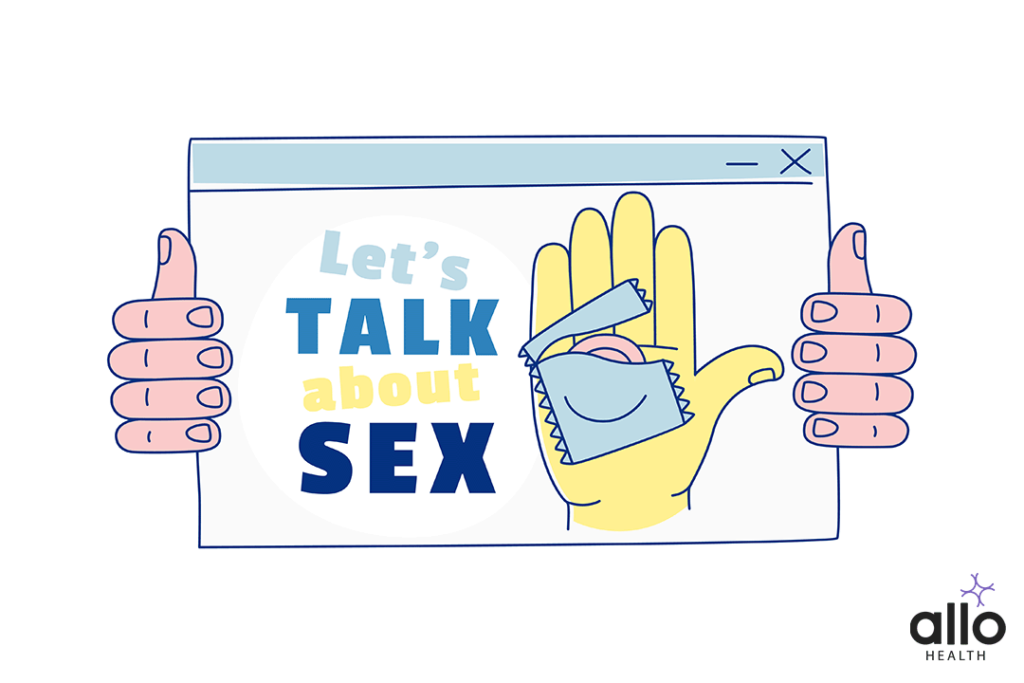Sex Education For Teens

Allo Health is dedicated to personalized well-being, offering support and trusted information tailored to individual health goals. The platform emphasizes human-generated content, led by a distinguished medical team of experts, including physicians and sexual health specialists. Their commitment to credibility involves rigorous fact-checking, authoritative research, and continuous updates to ensure accurate, up-to-date information. Allo Health's unique approach goes beyond conventional platforms, providing expert-led insights and a continuous commitment to excellence, with user feedback playing a crucial role in shaping the platform's authoritative voice.

A psychologist with clinical specialization and experience working with sub-clinical and clinical populations. Her areas of interest and expertise include anxiety-related disorders, mood disorders, psychotic disorders, addictions, sexual health and wellness, relationship issues, stress, and geriatric mental health.

Anoush Gomes is a seasoned Content Writer with over 10 years of experience, specializing in various writing styles such as medical content, creative writing, storytelling, and research papers. Anoush embarked on a unique journey, starting with pre-medical studies at the Dante Aligheri Academy and the University of Miami, where she earned a Bachelor's degree with a major in Biology and a minor in Psychology. Having pursued medical school and completed clinicals, Anoush transitioned to the world of medical content writing, where her passion for both healthcare and writing converged. Her writing skills encompass persuasive, narrative, expository, and descriptive styles, making complex medical concepts accessible to diverse audiences. Beyond her professional endeavors, Anoush is a multi-faceted individual with a rich tapestry of interests. A writer, artist, poet, avid reader, certified nerd, and hopeful author, she finds inspiration in the intersection of creativity and science. Whether crafting engaging medical narratives or weaving captivating stories, Anoush combines her diverse background and writing expertise to deliver compelling content that resonates with diverse audiences.
Why This Was Upated?
Our experts continually monitor the health and wellness space, and we update our articles when new information became available.
Updated on 23 June, 2024
- Article was updated as part of our commitment to diversity, equity, and inclusion.

"The following blog article provides general information and insights on various topics. However, it is important to note that the information presented is not intended as professional advice in any specific field or area. The content of this blog is for general educational and informational purposes only.
Book consultation
The content should not be interpreted as endorsement, recommendation, or guarantee of any product, service, or information mentioned. Readers are solely responsible for the decisions and actions they take based on the information provided in this blog. It is essential to exercise individual judgment, critical thinking, and personal responsibility when applying or implementing any information or suggestions discussed in the blog."
"The following blog article provides general information and insights on various topics. However, it is important to note that the information presented is not intended as professional advice in any specific field or area. The content of this blog is for general educational and informational purposes only.
Book consultation
The content should not be interpreted as endorsement, recommendation, or guarantee of any product, service, or information mentioned. Readers are solely responsible for the decisions and actions they take based on the information provided in this blog. It is essential to exercise individual judgment, critical thinking, and personal responsibility when applying or implementing any information or suggestions discussed in the blog."
Sex education is a critical aspect of a young person’s development. It equips them with the knowledge and skills to make informed decisions about their sexual health, including contraception, STI prevention, and consent. Unfortunately, sex education is still a taboo topic in many cultures, and parents or guardians may feel uncomfortable discussing it with their children.
Comprehensive Sexuality Education for Teens
Sex education for teens is a broad term that covers various topics related to sexual health and relationships. It includes information on puberty, anatomy, sexual orientation, gender identity, and relationships. Additionally, sex education for teens covers important topics such as contraception, pregnancy, STIs, and sexual consent.
Puberty
Puberty is a crucial time in a teenager’s life. It is a period when their bodies undergo significant changes. During puberty, teenagers experience hormonal changes that lead to physical changes, including the development of secondary sexual characteristics. Sex education for teens includes information on puberty and its effects on their bodies. It helps them understand what to expect during this time and how to cope with the changes.
Anatomy
Sex education for teens includes information on the anatomy of the reproductive system. This includes understanding the male and female reproductive organs and their functions. Teenagers learn about the menstrual cycle, ovulation, and fertility. Additionally, they learn about the male reproductive system, including the testes, penis, and prostate gland.
Sexual Orientation and Gender Identity
Sex education for teens also covers topics related to sexual orientation and gender identity. Teenagers learn about different sexual orientations, including heterosexual, homosexual, and bisexual. They also learn about gender identity and the importance of respecting other people’s gender identity and sexual orientation.
Contraception
Contraception is an essential part of sex education for teens. It helps teenagers understand how to prevent unwanted pregnancies and protect themselves from STIs. Teenagers learn about different types of contraception, including condoms, birth control pills, and intrauterine devices (IUDs). They also learn how to use contraception correctly and how to access it.
Pregnancy
Sex education for teens includes information on pregnancy and childbirth. Teenagers learn about the stages of pregnancy, prenatal care, and childbirth. They also learn about the different options available to them if they become pregnant, including adoption and abortion.
Sexually Transmitted Infections
STIs are a significant concern for sexually active teenagers. Sex education for teens includes information on STIs and how to prevent them. Teenagers learn about the different types of STIs, including HIV, herpes, chlamydia, and gonorrhea. They also learn about how to protect themselves from STIs, including using condoms and getting regular STI testing.
Sexual Consent
Sexual consent is a crucial topic in sex education for teens. Teenagers learn about the importance of respecting boundaries and the concept of enthusiastic and informed consent. They learn about the legal and ethical aspects of sexual consent and the importance of communication in sexual relationships.
The Importance of Sex Education for Teens
Teenagers are at a stage in their lives where they are experiencing physical, emotional, and social changes. These changes can be confusing and overwhelming, especially when it comes to their sexuality. Sex education provides them with the information and skills they need to make healthy and informed decisions about their sexual health. Here are some of the reasons why sex education is crucial for teenagers:
STI Prevention: Sexually transmitted infections (STIs) are common among sexually active teens. Sex education teaches them about the risks of STIs and how to prevent them. This includes using condoms, getting regular STI testing, and understanding the symptoms of different infections.
Contraception: Teenage pregnancy is a significant concern. Sex education helps teenagers understand the various contraceptive methods available, their effectiveness, and how to use them. This knowledge can help them make informed decisions about their sexual health and prevent unintended pregnancies.
Consent: Consent is an essential part of healthy sexual relationships. Sex education teaches teenagers about the importance of consent and what it means. This includes understanding boundaries, respecting others’ decisions, and recognizing the signs of coercion or pressure.
Healthy Relationships: Sex education helps teenagers understand what healthy relationships look like. It teaches them how to communicate effectively, respect each other’s boundaries, and recognize signs of abuse or unhealthy behavior. This knowledge can help teenagers build positive and healthy relationships in the future.
A Positive and Open Attitude For Sex Education for Teens
A positive and open attitude towards sex education is crucial for several reasons.
First, it helps create a safe and non-judgmental environment for teenagers to learn about sex. Adolescence can be a confusing and challenging time, and teenagers need a space where they can ask questions and explore their curiosity without fear of shame or embarrassment.
Second, a positive and open attitude towards sex education helps reduce stigma and shame surrounding sex. Many teenagers may feel ashamed or embarrassed about their sexual desires or experiences, which can lead to negative mental health outcomes. By promoting a positive and open attitude towards sex education, we can help reduce these negative feelings and promote a healthy view of sexuality.
Third, a positive and open attitude towards sex education helps to promote healthy relationships and communication skills. By encouraging teenagers to talk openly and honestly about their desires and boundaries, we can help them build strong and healthy relationships based on mutual respect and trust along with getting them comfortable with intimate talk.
How can we promote a positive and open attitude in sex education?
There are several ways we can promote a positive and open attitude towards sex education. One way is by providing comprehensive and inclusive sex education that addresses a variety of topics, including consent, healthy relationships, and LGBTQ+ concerns. This can help reduce stigma and promote understanding and acceptance of different sexual orientations and identities.
Another way to promote a positive and open attitude towards sex education is by encouraging open and honest communication. Teachers and parents can create a safe space for teenagers to ask questions and share their thoughts and feelings about sex. This can be done through group discussions, one-on-one conversations, or anonymous question boxes.
Finally, it’s essential to avoid shame and judgment when discussing sex education. Teenagers need to feel that they can talk openly and honestly about their experiences without fear of being judged or shamed. By promoting a positive and non-judgmental attitude towards sex education, we can help to create a safe and healthy environment for teenagers to learn about sex.
Understanding Contraception Methods

Sex education is an important aspect of teenage life, and one of the most crucial parts of it is understanding contraception or birth control methods. Teenagers need to be aware of the various contraception methods available to them to ensure they are sexually responsible and avoid unintended pregnancy and sexually transmitted infections (STIs). In this article, we’ll be discussing the various contraception methods that are available to teenagers.
Condoms: Condoms are one of the most common and effective contraception methods available. They are easy to use, inexpensive, and protect against both pregnancy and STIs. Condoms work by creating a barrier that prevents sperm from entering the vagina, thus reducing the risk of pregnancy. They also protect against STIs by preventing bodily fluids from coming into contact with each other.
Birth Control Pills: Birth control pills are a hormonal method of contraception that work by preventing ovulation. They contain synthetic versions of the hormones estrogen and progesterone, which are naturally produced in the body. When taken correctly, birth control pills are up to 99% effective in preventing pregnancy. However, they do not protect against STIs.
Intrauterine Devices (IUDs): IUDs are a long-acting and reversible method of contraception. They are small, T-shaped devices that are inserted into the uterus by a healthcare provider. There are two types of IUDs: hormonal and non-hormonal. Hormonal IUDs work by releasing a small amount of progesterone into the uterus, which thickens the cervical mucus and prevents sperm from reaching the egg. Non-hormonal IUDs are wrapped in copper, which creates an environment that is toxic to sperm. IUDs are up to 99% effective in preventing pregnancy and can last for up to 5-10 years.
Diaphragms: A diaphragm is a shallow, dome-shaped device made of silicone that is inserted into the vagina before sex. It covers the cervix and prevents sperm from entering the uterus. Diaphragms need to be used in combination with spermicide to be effective, and they must be fitted by a healthcare provider. They are up to 94% effective in preventing pregnancy.
Contraceptive Implants: Contraceptive implants are a long-acting method of contraception that are inserted into the arm by a healthcare provider. They contain synthetic progesterone, which prevents ovulation. Contraceptive implants are up to 99% effective in preventing pregnancy and can last for up to 3-5 years.
Emergency Contraception: Emergency contraception, also known as the morning-after pill, is a form of contraception that can be taken up to 72 hours after unprotected sex to prevent pregnancy. It works by delaying or preventing ovulation. Emergency contraception is not intended for regular use and should only be used in emergency situations.
It is important to note that no contraception method is 100% effective, and they all have potential side effects. It is important for teenagers to talk to their healthcare provider about which contraception method is best for them and to use them correctly and consistently to ensure maximum effectiveness.
Understanding First-Time Sex

First-time sex can be a daunting experience for many teenagers, and it is normal to feel nervous or unsure. However, with proper education and preparation, it can be a positive and enjoyable experience. Here are some things to consider:
Consent
Consent is crucial in any sexual encounter, including the first time. Both partners must give clear and enthusiastic consent before engaging in sexual activity. It is essential to communicate openly and honestly with your partner and respect their boundaries and wishes.
Contraception
Using contraception is important to prevent unintended pregnancy and reduce the risk of STIs. There are several options available, including condoms, birth control pills, and intrauterine devices (IUDs). It is essential to discuss these options with your partner and healthcare provider to determine what is best for you.
Communication
Effective communication is essential during sexual activity. It is crucial to discuss what feels good, what doesn’t, and any concerns or fears you may have. Open communication can improve your sexual experience and build trust and intimacy with your partner.
Safety
Ensuring your safety during sexual activity is crucial, especially when it comes to preventing STIs. It is important to use condoms, get tested regularly, and discuss any concerns or symptoms with your healthcare provider.
How To Prepare For First-Time Sex
Preparing for first-time sex can help reduce anxiety and improve your sexual experience. Here are some things to consider:
Self-Exploration
Understanding your body and sexual feelings can help you communicate your needs and desires to your partner. Take time to explore your body, including your erogenous zones, and learn what feels good to you.
Education
Proper education about sex, contraception, and STIs is essential to making informed decisions about your sexual health. Talk to a trusted adult or healthcare provider or attend sex education classes to learn more.
Comfort
Being comfortable with your partner and the environment is essential during sexual activity. It is crucial to communicate openly with your partner, set boundaries, and create a comfortable and safe space for sexual activity.
Consent
As mentioned earlier, consent is crucial during any sexual activity, including the first time. It is essential to discuss boundaries and respect your partner’s wishes to ensure a positive and respectful sexual experience.
Understanding Intimacy
Sex education for teens is a crucial topic that requires attention and understanding from both parents and educators. The term “sex education” can elicit different reactions from people, ranging from anxiety and discomfort to openness and acceptance. However, the fact remains that sex education is essential for teenagers to navigate their sexual lives safely and responsibly.
One of the critical aspects of sex education is understanding intimacy. Intimacy is an essential part of human relationships, and it refers to the emotional and physical closeness between two people. It encompasses a range of experiences, from holding hands and kissing to sexual intercourse. In this article, we will explore what intimacy means for teenagers and how sex education can help them develop healthy relationships.
What Is Intimacy?
Intimacy is a complex concept that involves emotional, physical, and psychological closeness between two people. It is not just about sex; it can be expressed in different ways, including holding hands, hugging, cuddling, and kissing. Intimacy can also involve deep conversations, sharing personal thoughts and feelings, and showing vulnerability.
For teenagers, intimacy is an important aspect of their social and emotional development. It helps them build connections with their peers and romantic partners, develop trust and empathy, and learn how to communicate effectively. However, intimacy can also be confusing and challenging, particularly for those who are exploring their sexuality for the first time.
Understanding Consent

One of the critical components of intimacy is consent. Consent means that both parties involved in sexual activity have agreed to participate willingly and enthusiastically. It is essential for teenagers to understand what consent means and how to ask for it and give it.
Teens need to learn that they have the right to say no to any sexual activity that makes them uncomfortable. They also need to understand that their partner’s consent is crucial and that they should never pressure or coerce someone into doing something they don’t want to do. Additionally, teens need to learn about the legal and emotional consequences of sexual assault and harassment.
The Role Of Sex Education
Sex education plays a vital role in helping teenagers understand intimacy and develop healthy relationships. Sex education can provide teens with accurate and age-appropriate information about sexual anatomy, contraception, and sexually transmitted infections. It can also help them understand the importance of consent, respect, and communication in relationships.
Sex education can take place in different settings, including schools, community centers, and online platforms. It is crucial that sex education is comprehensive, inclusive, and non-judgmental. This means that it should cover topics, such as gender identity, sexual orientation, and diversity, to ensure that all teens feel seen and heard.
Talking To Your Teen About Intimacy
Parents and caregivers can also play a crucial role in helping their teens understand intimacy. It can be challenging to talk to your teen about sex and relationships, but it is essential to have open and honest conversations with them.
Start by asking your teen what they know about sex and relationships and what questions they have. Listen to their responses and provide accurate and age-appropriate information. It is essential to create a safe and non-judgmental environment where your teen feels comfortable asking questions and expressing their thoughts and feelings.
Understanding Gender Identity and Sexuality
Sex education is an essential aspect of a teenager’s development. Adolescence is a time of great change, both physically and emotionally, and it is crucial to provide young people with the knowledge and skills they need to navigate this phase of their lives. One of the most important topics to cover in sex education is gender identity and sexuality.
Gender identity refers to a person’s internal sense of being male, female, both, or neither. Sexual orientation refers to a person’s sexual attraction to others. While these concepts may seem straightforward, they can be complex and nuanced, especially for young people who are still exploring their identities.
Here are some key things to keep in mind when teaching sex education to teens.
Use Inclusive Language
When discussing gender identity and sexuality, it is essential to use language that is inclusive and respectful of all individuals. This means avoiding gendered language (such as “boys and girls” or “men and women”) and instead using gender-neutral language (such as “people” or “youth”).
It is also crucial to be aware of the diversity of gender identities and sexual orientations. For example, not all people identify as male or female, and not all people are exclusively attracted to the opposite gender. Using inclusive language acknowledges and respects this diversity.
Encourage Self-Exploration
One of the most important aspects of sex education is encouraging young people to explore their own identities. This means creating a safe and supportive environment where teens feel comfortable asking questions and sharing their thoughts and feelings.
Encouraging self-exploration also means providing resources and information about different gender identities and sexual orientations. This can include sex education books, articles, videos, and other materials that provide a broad understanding of the topic.
Discuss Consent
Consent is a crucial aspect of any sexual relationship, regardless of gender identity or sexual orientation. It is important to teach teens about the importance of consent and how to communicate their own boundaries and respect the boundaries of others.
Consent means that all parties involved have freely given their agreement to engage in sexual activity. It is never okay to pressure or coerce someone into sexual activity, and consent cannot be given if a person is under the influence of drugs or alcohol, or if they are unable to give consent for any reason.
Address Stigma and Discrimination
Unfortunately, there is still a great deal of stigma and discrimination surrounding gender identity and sexuality. It is important to address these concerns head-on and teach young people about the harmful effects of discrimination and bias.
This means discussing topics such as homophobia, transphobia, and gender-based violence. It also means providing resources and support for teens who may be experiencing discrimination or harassment.
Provide Access to Resources
Finally, it is crucial to provide teens with access to resources and support. This can include resources such as counseling services, LGBTQ+ support groups, and medical care.
It is also important to provide teens with accurate and comprehensive information about sexual health and contraception. This includes information about safe sex practices, birth control options, and sexually transmitted infections (STIs).
Sex education is a crucial component of a teenager’s growth and development. It refers to the process of educating adolescents on various aspects of sexuality, including anatomy, contraception, relationships, and consent. Sex education is essential in providing adolescents with the tools and knowledge necessary to make informed decisions about their sexual health. In this article, we will discuss the benefits of sex education for teenagers on their physical, emotional, sexual, and reproductive growth and development.
The Benefits Of Sex Education For Teens on Growth and Development
Physical Benefits
One of the primary benefits of sex education is that it can help adolescents stay healthy physically. When adolescents have access to accurate and reliable information about sexual health, they are more likely to make informed decisions about their bodies. They can learn about contraception and safe sex practices, which can reduce the risk of unintended pregnancies and sexually transmitted infections (STIs). Additionally, sex education can teach teenagers about the importance of regular check-ups and screenings to detect any potential health concerns early on.
Emotional Benefits
Sex education can also benefit teenagers emotionally. Adolescence can be a challenging time, and navigating the complexities of sexual relationships can be even more challenging. Sex education can provide teenagers with the knowledge and skills necessary to build healthy relationships based on respect and communication. It can also help them understand and recognize unhealthy relationship dynamics, including those involving coercion and abuse.
Sexual Benefits
Sex education can benefit teenagers sexually by promoting healthy sexual development. Adolescents who have access to comprehensive sex education are more likely to delay their first sexual experience and have fewer sexual partners. Additionally, sex education can help teenagers learn about sexual pleasure and explore their sexuality in a safe and consensual manner.
Reproductive Benefits
Another significant benefit of sex education is that it can help teenagers understand their reproductive development and health. Adolescents can learn about the menstrual cycle, fertility, and pregnancy prevention. Sex education can also teach teenagers about the various options for childbirth, including natural childbirth and cesarean delivery.
Understanding STDs and STIs
Teaching STDs and STIs in sex education can be challenging, but it’s essential to provide accurate information in an age-appropriate and culturally sensitive manner. Here are some tips for teaching STDs and STIs in sex education:
Use age-appropriate language: Use language that is appropriate for the age and developmental stage of the teenager. Avoid using medical jargon or slang.
Use visual aids: Visual aids such as diagrams, videos, and illustrations can help teenagers understand the anatomy of the reproductive system and how STDs and STIs are transmitted.
Address myths and misconceptions: Addressing common myths and misconceptions about STDs and STIs can help teenagers develop accurate knowledge about sexual health.
Encourage questions: Encourage teenagers to ask questions and provide a safe and non-judgmental environment for discussion.
Impact of Lack Of Comprehensive Sex Education For Teens
The lack of formal or comprehensive sex education for teens can have a significant impact on various aspects of their lives, including their physical and mental health, relationships, and overall well-being.
Increased risk of unintended or unplanned pregnancy: Without proper sex education, teens may lack knowledge about contraception and safe sex practices, which can lead to unintended pregnancies and the associated physical, emotional, and financial consequences.
Higher rates of sexually transmitted infections (STIs): Teens who are not educated about safe sex practices are more likely to engage in unprotected sex, which increases their risk of contracting STIs.
Increased risk of sexual violence: Without knowledge about consent and healthy relationships, teens may be at a higher risk of experiencing sexual violence, abuse, or coercion.
Negative impact on mental health: The lack of sex education can lead to feelings of shame, guilt, and confusion around sexuality, which can have negative impacts on mental health and self-esteem.
Reinforcement of gender stereotypes: The absence of sex education can perpetuate gender stereotypes and contribute to discrimination and inequality, particularly for women and LGBTQ+ individuals.
Reduced access to healthcare: The lack of knowledge about sexual health may discourage teens from seeking healthcare services, which can further exacerbate health concerns and inequalities.






































